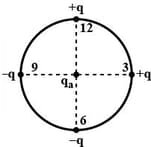HARD
Earn 100
Four charges are placed at the circumference of the dial of a clock as shown in figure. If the clock has only hour hand, then the resultant force on a positive charge placed at the centre, points in the direction which shows the time as , find :-

50% studentsanswered this correctly
Important Questions on Electric Charges and Fields
EASY
MEDIUM
HARD
HARD
EASY
EASY
MEDIUM
EASY
HARD
MEDIUM
EASY
(Take )
HARD
EASY
EASY
Two charges of equal magnitudes and at a distance exert a force on each other. If the charges are halved and distance between them is doubled, then the new force acting on each charge is
EASY
EASY
MEDIUM
EASY
EASY
Let denote the dimensional formula of the permittivity of vacuum. If M = mass, L = length, T = time and A = electric current, then :
HARD

